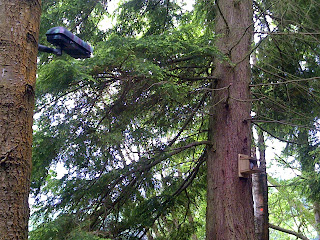Towering over the North East shore of Windermere Cumbria and the tallest of their kind in England
| The arboretum created by plant hunters over 150 years ago |
You’d be forgiven for not seeing the majestic wood as you negotiate busy traffic and sharp bends in the road to Ambleside. But once seen, the wood and its colossal trees will stand out for miles around.
Unlike the tall trees of other continents these can be reached in only a few minutes walk from Waterhead, just south of Ambleside and close to public transport links including the ferry. Skelghyll wood is already very popular with walkers and cyclists travelling from Ambleside to Troutbeck via the very popular viewpoint called Jenkins Crag.
Visitors to Stagshaw gardens at Skelghyll wood will have already seen a glimpse of the tall trees, but now we’ve opened up a brand new path to enable visitors to marvel, up close and personal at the Champion trees.
| A young visitor marvels at the size of a Wellingtonia |
The Victorians, famous for their plant hunting had a big influence on Skelghyll wood and planted over 150 specimen conifer trees from all over the world including South and North America, Japan and Europe . Some of these have trees have thrived on the lush wooded slopes and survived harsh winters and storms to become over 50 meters high – higher than 12 double-decker busses stacked on top of each other.
The tallest is a Grand fir measuring 58 meters (190ft) high making it the tallest tree in Cumbria and the North West, and the tallest Grand fir in England. Other Champion trees found in the wood include Douglas fir, Wellingtonia, Western Red cedar, Hondo spruce and Blue Colorado spruce, all of which are the tallest of their kind in Cumbria
 |
| The residents of Wansfell Holme planted trees from around the world as a way to show off their wealth and status |
The planting vision set out in 1860 by the Victorians can finally be appreciated and the new Champion Tree Trail is a ‘must-see’ for anyone interested in trees, history or simply being in wonderful places that make you realise that nature is capable of huge things.
Although the path is now open the story has only just started. We want to plant what will be champions of the future and to add to the new trail, making it a favourite place for generations to come.
The adventure for you and your family can begin in Waterhead and simply walking to Skelghyll wood or parking at Stagshaw Gardens
Take 45 minutes to stroll in sturdy footwear along the route taking advantage of picnic benches to marvel at what nature can do, with a little help from Victorian plant hunters.
| Beetles like this Longhorn (Rhagium mordax) love Skelghyll Wood too! |
The trail is available to download as a PDF at
If you would like find out more about the trees or read our donations wish list please get in touch with Ben Knipe – Woodland Ranger on 015394 46402 or email Benjamin.knipe@nationtrust.org.uk
Enjoy your walk and don’t forget to pack a picnic!












